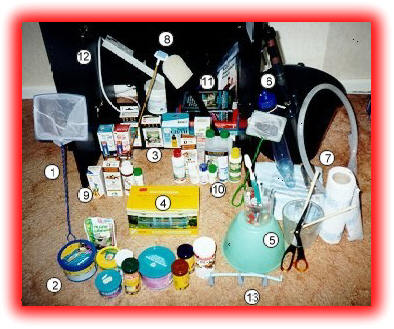|
The good thing about starting up a tropical freshwater tank is that its the
best system for a beginner, because its relatively cheap and
the fish are quite hardy. Saltwater fish are very expensive, and
you will need a lot of knowlegde and technique.
When you have bought a tank you must remember these points:
Wash the gravel: Put it in a bowl, place it under a running
tap and keep stirring the gravel until the water that flows from it
becomes clean. Really get in there and nead that gravel, get it as clean as possible.
Decorating material: Wash the rocks as well. If you have a
background secure it firmly.
Clean the tank: Clean the tank, check for leaks, then empty it.
Everything is correct: before you fill in the tank, check
that everything is right - filter, heater, light, thermostat.
Knowledge: I bought several books when things started
going wrong, and I recommend that you look extensively around other
Tropical Fish websites as well.
Now that you all ready to jump on the bandwagon, these steps
should help you:
Add the gravel: Make sure that theres enough, because
the plants will want to root. If you want an underground filter,
use at least a depth of 5 cm at the front and rising to double at the back.
Add the water half way: Now you can add any plants easily. Best to put the taller ones at the back,
but its all in the eye of the beholder. Make sure that the plants have enough gravel to root,
and cutting might be needed. Don't disturb the gravel, use a plate or
an object to weaken its force. It is probably best if you use a hose.
Install the filter: Attach it so no plants or rocks
are in the way. Attach heater and thermostat firmly.
Add the rocks: If you use a large rock, make sure
that it is firmly bedded in so that it can never topple other.
Add the water all the way: Watch out as well, because if you fill
it right to the brim, then later you want to change the arrangement and
put your hands in - whoops!
Important!! Condition the water: Before adding any fish,
you must get rid of all the chlorine from the water. Chlorine/Chloramine can damage the fish
, and there are a lot of "tap water conditioners"
on the market, so buy one NOW!!
Turn it on: Set up you lighting system if you have one,
You should get a noise and a flow of bubbles when you turn the
filter on, and then to a more steady flow. Before adding any fish,
let the filter run for 5-7 days, so any last chlorine can escape. Also, you may notice that there
maybe
a lot of bubbles clinging to the glass - this is because tap water is pressurised, and as cold
water is warmed and left in the aquarium, gasses are released. Let these dissipate, as they will disappear
when aerated.
Its not a bad idea to add a couple of flakes without the fish, to start off the Nitrogen Cycle before your fish arrive. Even better, take some water from an
established aquarium, and plonk it in. If you can "nick" some media (gravel, decor, plants) will
all be helpful.
There's no fixed limit there, as this will
get the cycle going. If there are sick fish in it, obviously try to find
different water. Also, "running in" a new aquarium in an established tank, will colonise it with beneficial bacteria.
There is always the option of a "fishless cycle", where ammonia is added to the aquarium.
Make sure that the temperature
is correct, at about 24C.
Add the fish!!: Add only a couple of fish to start off with. Use the Equalising method, by floating the
fish using their bag. Leave them there for 15 - 20 minutes. Then
release them.
Things you can use

1) Net: Very useful, for obvious reasons.
2) Food: Don't run out, the fish wont be amused.
3) Test Kits: Checking the PH, Hardness and Toxins levels in your aquarium is always useful.
4) Nursery/Breeding tank: Useful to isolate a sick fish, pregnent fish, or fry.
5) Water bowls: Cleaning the filter(foam, Carbon granule, Bio-max) where I use a litre of aquarium water,
as using tap water destroys any useful bacteria.
6) Gravel vacuum: There it takes the water out discreetly,
not stressing the fish.
7) Bucket, Towel, Tissues: I have a marked bucket (Litres), useful for water changes.
Quick dry of the hands, watching for electrical socket etc.
8) Algae scraper: I have a scraper and a stiff sponge, both are efficient at
removing algae from the water.
9) Fish Medication: You are bound to have one or two diseases in your aquarium.
Always stock them away from sunlight and in a cool place. Salt can be used.
10) Books: These days, knowledge is power. Well alright, maybe
you won't become Prime Minister because you know everything about the fish hobby,
but buying a good fish book would be invaluable to you.
11) Drip loop: Look in "Hints and tips" page about the Drip loop.
12) Air pump: Not the actual pump of course, this long tube
is placed in your tank and helps aeration. A airstone can be used. Check out
the page "Aeration and Filtration" for more details
|







